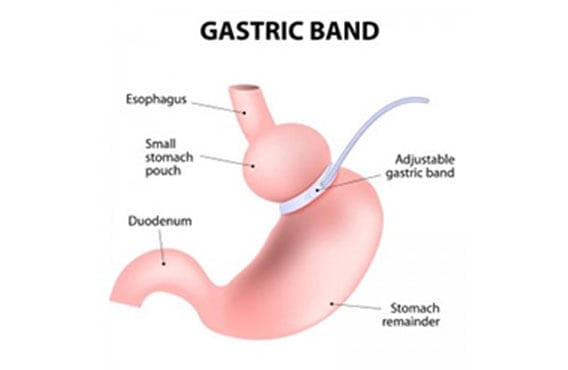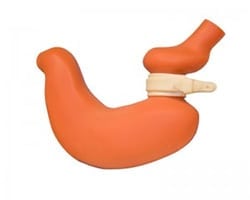
Let a Lap-Band Revision put you back on the right track.
Revision for Lap-Band refers to the need to perform another surgery due to an issue with the initial Lap-Band procedure. The reason for the need for Lap-Band revision may include a slip of the band out of its original position or medical issues necessitating the complete removal of the band.
- The need for revision surgery doesn’t always mean the procedure has failed for the patient
- Many patients will continue to lose weight if they were seeing encouraging results following the initial Lap-Band procedure
When Revision Becomes Necessary
 The placement of the band is essential to the success of a Lap-Band procedure. The band may slip for many reasons. While rare, slippage of the band may lead to a chronic or acute condition requiring immediate attention. In some cases, the band may cause an erosion of the stomach tissue where it’s located. Depending on the circumstances involved, vertical sleeve gastrectomy, a procedure where a large portion of the stomach is removed, may be recommended as an alternative to the placement of a band. Treatment may require removal of the band, re-positioning it, or replacing it with a new band.
The placement of the band is essential to the success of a Lap-Band procedure. The band may slip for many reasons. While rare, slippage of the band may lead to a chronic or acute condition requiring immediate attention. In some cases, the band may cause an erosion of the stomach tissue where it’s located. Depending on the circumstances involved, vertical sleeve gastrectomy, a procedure where a large portion of the stomach is removed, may be recommended as an alternative to the placement of a band. Treatment may require removal of the band, re-positioning it, or replacing it with a new band.
Your doctor can help you determine if revision or another type of procedure is best based on your unique situation. Each patient is different and has different needs, so a conversation with your doctor is the best way to determine what you need.
Revision After Initial Success
 For patients who have otherwise positive results with the surgery, Lap-Band replacement or re-positioning is often recommended if the issue is strictly technical in nature, as would be the case with slippage of the band, which may occur anywhere from several weeks to months after the first procedure. Prior to revision surgery, a patient will be thoroughly evaluated to determine total weight loss experienced since the first procedure, the extent of the issues that are making a revision necessary, and the extent of their overall health improvements since the original Lap-Band operation.
For patients who have otherwise positive results with the surgery, Lap-Band replacement or re-positioning is often recommended if the issue is strictly technical in nature, as would be the case with slippage of the band, which may occur anywhere from several weeks to months after the first procedure. Prior to revision surgery, a patient will be thoroughly evaluated to determine total weight loss experienced since the first procedure, the extent of the issues that are making a revision necessary, and the extent of their overall health improvements since the original Lap-Band operation.
After the correction, patients deemed to be ideal candidates for re-positioning or replacement of the band often resume with their weight loss and continue to see positive results from the Lap-Band operation. As with the initial surgery, careful monitoring will also be required to ensure that there are no issues with the correction procedure. Just as the initial Lap-Band procedure required careful instructions regarding diet and recovery, the revision surgery requires the same level of attention in order to see weight loss.
When Another Restrictive Procedure Isn’t Recommended
Some patients may not have any success with the initial procedure. This would apply to patients who’ve had only minimal weight loss or overall health improvements from the first Lap-Band surgery. If this is the case, another restrictive operation may not be recommended and the band will be removed without replacement or re-positioning. Instead, a gastric bypass or duodenal switch may be more appropriate. Your doctor can tell you about the different options that are available.
Ultimately, the decision to proceed with another restrictive surgery depends on how the patient has responded to the first surgery. Risk of complications is another consideration, especially since some procedures have higher rates of complications than others.
Single or Double-Stage Procedures
 Any type of Lap-Band revision may be performed as a single-stage procedure where the band is removed and another surgery technique is performed at the same time. A two-stage procedure is when the band is removed during the revision procedure and another technique is performed during a follow-up surgery. The two-stage option may be recommended for patients with a higher risk of developing complications, to allow time for healing.
Any type of Lap-Band revision may be performed as a single-stage procedure where the band is removed and another surgery technique is performed at the same time. A two-stage procedure is when the band is removed during the revision procedure and another technique is performed during a follow-up surgery. The two-stage option may be recommended for patients with a higher risk of developing complications, to allow time for healing.
While the preferred option will depend on individual circumstances, most surgeons prefer a single-stage procedure. Another option is to simply re-position or replace the band during the revision procedure. If the band has to be removed due to complications, a two-stage operation may also be recommended.
Life After Lap-Band Revision
Weight loss following a successful Lap-Band revision can continue for the patient. This is especially true if there were technical issues with the initial placement of the band. Risk of complications is low for patients who are relatively healthy going into a revision procedure, according to available studies on post-surgery success with such techniques.
 If the band has been replaced, patients will be encouraged to stick to their recommended diet and report any issues with the procedure to their doctor. Regardless of the type of revision involved, patients will need to allow time to properly heal after the surgery, which means avoiding unnecessary abdominal pressure. For patients whose insurance covered the initial Lap-Band surgery, removal, re-positioning, or the performing of another procedure will likely be covered as well, although policy terms will be specific to each patient and their particular type of insurance coverage.
If the band has been replaced, patients will be encouraged to stick to their recommended diet and report any issues with the procedure to their doctor. Regardless of the type of revision involved, patients will need to allow time to properly heal after the surgery, which means avoiding unnecessary abdominal pressure. For patients whose insurance covered the initial Lap-Band surgery, removal, re-positioning, or the performing of another procedure will likely be covered as well, although policy terms will be specific to each patient and their particular type of insurance coverage.
The decision on how to proceed when a Lap-Band revision is necessary should be just as carefully considered as the decision was to opt for Lap-Band surgery in the first place. Should the Lap-Band procedure fail because a patient has difficulty following dietary suggestions or metabolism issues affecting results, revision may not be recommended. Instead, a patient may be directed towards other weight loss efforts. If, however, a patient had been seeing positive results prior to the issue with the band, re-positioning will likely to be recommended. As with the original procedure, Lap-Band revision is a serious operation requiring sufficient recovery time and adherence to dietary guidelines and follow-up instructions.
To learn more about this type of procedure and to explore your options for weight loss surgery, contact our office today. The first step in your revision involves a consultation where you can talk with your doctor about your health, medical history, current situation, and weight loss goals. After a thorough evaluation, you and your doctor will be able to make a decision about the next step that is best for you and your situation.







